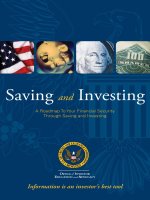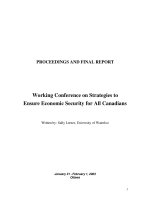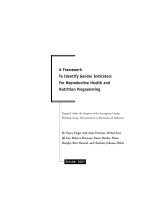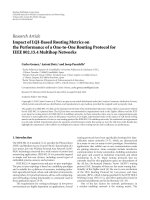Rescuing retirement a plan to guarantee retirement security for all americans
Bạn đang xem bản rút gọn của tài liệu. Xem và tải ngay bản đầy đủ của tài liệu tại đây (1.03 MB, 183 trang )
RESCUING
RETIREMENT
A Plan To Guarantee Retirement Security For All Americans
T E R E S A G H I L A R DU C C I
T O N Y JA M E S
foreword by TIMOTHY GEITHNER
RESCUING
RETIREMENT
Rescuing
Retirement
A PLAN TO GUARANTEE
RETIREMENT SECURITY
FOR ALL AMERICANS
Teresa Ghilarducci
and Tony James
Foreword by Timothy Geithner
Columbia University Press | New York
Columbia University Press
Publishers Since 1893
New York Chichester, West Sussex
cup.columbia.edu
Copyright © 2018 Teresa Ghilarducci and Hamilton E. James
All rights reserved
Library of Congress Cataloging-in-Publication Data
Names: Ghilarducci, Teresa, author. | James, Tony, 1951- author.
Title: Rescuing retirement: a plan to guarantee retirement security
for all Americans / Teresa Ghilarducci and Tony James.
Description: 1 Edition. | New York : Columbia University Press, [2018] |
Includes bibliographical references and index.
Identifiers: LCCN 2017035932 (print) | LCCN 2017037759 (ebook)
| ISBN 9780231546270 | ISBN 9780231185646 (alk. paper)
Subjects: LCSH: Retirement income—United States—Planning. |
Retirement—United States—Planning.
Classification: LCC HG179 (ebook) | LCC HG179 .G4734 2018 (print) |
DDC 332.024/01450973—dc23
LC record available at />
Columbia University Press books are printed on permanent
and durable acid-free paper.
Printed in the United States of America
Cover design: Lydia Fine
Cover photograph: Peter Dazeley ©GettyImages
To our mothers, Waleska James and Marion Ghilarducci, for
their support for us and their generosity of spirit toward the
world at large.
To the next generation, especially Joseph Ghilarducci O’Rourke
and Genevieve McGahey, and Meredith, Becky, and Ham James.
And to all the retirees of tomorrow, who are entitled to retire
with dignity.
Our plan would guarantee millions of Americans safe and secure
retirements that would benefit them, their families, and the nation’s
economy.
—Teresa Ghilarducci and Hamilton E. James.
“A Smarter Plan to Make Retirement Savings Last,”
New York Times, January 1, 2016
CONTENTS
Foreword by Timothy Geithner xi
Acknowledgments xiii
1 SOCIETY’S RETIREMENT CRISIS
1
2 HOW WE GOT HERE: AMERICA’S BROKEN
RETIREMENT SYSTEM 15
3 SIX KEY PROBLEMS: THE CONSEQUENCES
OF A BROKEN RETIREMENT SYSTEM 31
4 RESCUING RETIREMENT: A FOUR-PRONGED
SOLUTION 43
5 CASE STUDIES: SIMILAR PLANS IN ACTION
83
6 WHY NOT JUST EXPAND SOCIAL SECURITY?:
AMERICANS NEED A UNIVERSAL PENSION SYSTEM
89
7 GROWING SUPPORT FROM THE AMERICAN PEOPLE
AND A MANDATE FOR CONGRESS 93
CONTENTS
8 THE EMPLOYER’S STAKE IN RETIREMENT
REFORM 99
9 CONCLUSION
103
Questions and Answers on the Guaranteed Retirement Account 105
Appendix A: The Cost of a Principal Protection Guarantee 113
Appendix B: GRAs Versus Other Policy Solutions 121
Appendix C: Looking at Retirement Coverage
Across the Country 131
Notes 135
Bibliography 147
Index 159
Q
x
Q
FOREWORD
TIMOTHY GEITHNER
T
he United States faces a discouraging mix of long-term
economic challenges and the diminished capacity of
the political system to deliver a framework of incentives and
investments that can address these challenges.
Among these challenges, the lack of retirement security is
one of the most daunting. As Teresa Ghilarducci and Tony
James write, this is a problem for the vast majority of working Americans. It won’t go away on its own. Without a substantial change in individual savings and investing behavior,
we face a future with tens of millions of elderly poor.
Americans typically save a relatively small portion of their
income. The savings rate moved a bit higher after the trauma
of the financial crisis of 2008, but it remains low. A large
majority of Americans do not have a financial cushion adequate to cover their immediate needs, much less their needs
in the decades they will live after they retire.
Neither the behavior of individuals nor economic policy
has adapted to a world in which people are living longer, health
care costs are expensive and rising, median income growth
is slower, and expected returns on financial assets are lower.
With the end of an employer-based defined-contribution
FOREWORD
system and with changes in the health care system, we have
shifted a lot of economic risk to the individual, but individuals are having a hard time adapting to that new reality.
Many other economies have enacted fundamental reforms
of their pension systems, but our system remains burdened
by some fundamental shortcomings. We have an elaborate
set of expensive tax preferences that appear to have little
effect on encouraging savings and whose benefits go disproportionately to the relatively fortunate. The savings products
that have succeeded the defined-benefit plans of the past are
designed in ways that enable the worst instincts of individual investors, without giving them access to the investment
models that allow them to gain some of the benefits of a
long-term investment horizon.
Unsustainable long-term deficits mean that individuals
have to contemplate a future with higher taxes and lower
benefits. Individuals will have to pay more for retirement
and more for health care during retirement. The longer-term
constraints on our fiscal resources mean we have to be careful
how we allocate those benefits today, including through the
tax code and its provisions designed to encourage savings.
Teresa Ghilarducci and Tony James make a powerful case
for reform, and they have designed a system better than what
we have today that would complement, not substitute for,
Social Security. Their proposal combines the best features
of the reforms adopted in other countries, without adding
an unrealistic and unaffordable commitment of future tax
resources. They approach the challenge without ideological
bias, guided by a refreshingly pragmatic focus on what the
evidence suggests is likely to work.
Q
xii
Q
ACKNOWLEDGMENTS
F
irst and foremost, we thank Will Pollock for his invaluable research, writing, and editing throughout this process. We also thank Christine Anderson and Peter Rose for
their enthusiastic support and encouragement. Pete Peterson
is an inspiration who proves that a lone voice can make a difference, and that business leaders bear an obligation to help
solve society’s problems. Neera Tanden got this all started by
asking us to do a policy speech in Washington, D.C. around
a new big idea.
Jeffrey Nussbaum, Michael Flynn, and Adam Talbot lent
their policy expertise and formidable writing skills to refine
the plan. Teresa’s New School colleagues, Rick McGahey,
Will Milberg, David VanZandt, Bridget Fisher, and Tony
Webb, are admirably determined and committed to advance
a constructive national plan for retirement security. Bridget
was indispensable in communicating this book’s ideas to the
media and to stakeholders, and Tony lent his expertise as an
economist to confirm many of our numbers.
ACKNOWLEDGMENTS
Throughout this process, we have been fortunate to
meet and speak with leading economists—including Erskine
Bowles, Austan Goolsbee, Glenn Hubbard, Alan Krueger,
Alicia Munnell, Larry Summers, Timothy Geithner, and
Robert Rubin—and with elected officials from across the
political spectrum. Republicans and Democrats alike have
expressed determination to find common ground to solve
the retirement crisis. We are profoundly grateful for their
commitment to this cause.
We also want to recognize the countless Americans struggling to do the right thing in a broken system: employers
who do all they can to provide retirement savings support
for their staff, and employees who work more hours per
week, more weeks per year, and more years per lifetime than
workers in most wealthy nations. These dedicated men and
women deserve a better retirement system, one in which
their money works as hard as they do to secure their standard
of living for the full span of their lives.
Q
xiv
Q
RESCUING
RETIREMENT
1
SOCIETY’S RETIREMENT CRISIS
“M
y retirement plan,” Robert Hiltonsmith told PBS’s
Frontline, “is ‘fingers crossed and pray,’ basically.
Yeah, win the lottery. . . . The truth is, [I’m] just going to have
to find a way to save way more than you should have to.”1
An economist in his mid-thirties, Robert’s plight captures
much of what is wrong with the U.S. retirement system.
Given his promising career and relative youth, he should
have all the tools he needs to plan for a comfortable retirement. But his outlook could not be more pessimistic—or
revealing.
A Society of Actuaries survey showed that a majority
of Americans believe retirement benefits should provide a
guaranteed amount monthly during retirement no matter
how long they live.2 But today, our retirement system is so
hopelessly broken—and so deeply confusing—that even
Americans with well-paying, full-time jobs their entire
adult lives are hard-pressed to guarantee a comfortable and
secure future.
SOCIETY’S RETIREMENT CRISIS
Tens of millions of lower-income workers face an even
more daunting challenge. Without significant savings, they
must try to continue working to the end of their lives, knowing that a single health crisis, accident, or layoff could spiral
them into poverty.
Retirement is a significant source of stress in people’s
lives (figure 1.1).
Our nation stands at a watershed moment. More Americans than ever are approaching retirement with inadequate
savings. Their numbers are poised to grow dramatically
in coming years because we are both saving less and living
longer. Further aggravating this problem is that too many
people—56 percent of men and 64 percent of women—
unwisely claim Social Security before full retirement age.3
Since 1980, the number of Americans making it into
their nineties has tripled. Today’s retirees will need their
38%
Saving enough for retirement
20%
Job security
26%
Credit card debt
29%
Monthly expenses
24%
Student loans
0%
5% 10% 15% 20% 25% 30% 35%
Percentage of 1,000 participants polled
Figure 1.1 Young workers say they’re worried about retirement. (Answers to
the question “What is a ‘significant source of stress’ in your life?”).
Source: Schwab Retirement Plan Services, Inc. (August 2016) 401(k) Participant Survey.
Q
2
Q
40%
SOCIETY’S RETIREMENT CRISIS
savings to last longer than ever.4 As life expectancies rise, the
prevailing retirement income plans—mostly 401(k)s and
Individual Retirement Accounts (IRAs)—are proving less
and less adequate. Our patchwork system leaves too many
people with paltry savings and anemic investment returns.
The U.S. experiment with 401(k)s and IRAs, launched
in the 1980s, has failed miserably to deliver on its promises.
Predatory fees, low returns, leakages, lump-sum payouts—
all have served to discourage or inhibit workers from accumulating enough for retirement. Here is the hard reality:
more than half of working people nearing retirement today
won’t have enough to maintain their standard of living.5
Among Americans between forty and fifty-five, the median
retirement account balance is $14,5006—less than 4 percent of the $375,000 the median-income worker will need
in savings.7
For the next generations of retirees—including today’s
young people—the challenges will be greater still. For the
past forty years, America’s median household income has
stagnated; ditto for entry-level wages. In real terms, our minimum wage has regressed to where it was in the 1940s, a time
when most workers were eligible for true pensions.
Meanwhile, health care costs are rising two to three times
faster than income; rent and child care expenses are escalating; and outstanding student loan debt has tripled over
the last decade to more than $1 trillion. When we compare
the last half-century to the next fifty years, productivity and
economic growth rates are projected to drop by half. Meanwhile, ultra-low-interest rates are depressing returns on any
savings we somehow manage to put aside.
Q
3
Q
SOCIETY’S RETIREMENT CRISIS
$40,000
$35,929
Retirement savings balance
$35,000
$30,000
$26,386
$25,000
$20,000
$17,000
$15,158
$15,000
$10,000
$8,000
$6,200
$4,200
$480
$5,951
$5,000
$1,123
$0
1989
1992
1995
32–37
1998
2001 2004
Year
2007
44–49
50–55
38–43
2010
2013
56–61
Figure 1.2 Median retirement account savings of families by age, 1989–2013
(2013 dollars).
When it comes to retirement savings, across all age groups,
the United States is acutely behind where it needs to be
(figure 1.2).
Given this stark reality, it is little wonder that a 2015 survey found that 86 percent of Americans believe “the nation
faces a retirement crisis.”8
Based on current trends, we will soon be facing rates of
elder poverty unseen since the Great Depression. Of the
18 million workers between ages fifty-five and sixty-four in
2012, 4.3 million were projected to be poor or near-poor
Q
4
Q
SOCIETY’S RETIREMENT CRISIS
when they turn sixty-five,9 including 2.6 million who were
part of the middle class before reaching retirement age.
Today, 15 million elderly people spend less than twelve
dollars per day for food. By 2035, nearly 20 million retirees
will be living in poverty or near-poverty. By 2050, that number will reach 25 million (figure 1.3).
As the U.S. population continues to simultaneously grow
and gray, and traditional pensions become relics of the past,
elderly people living in deprivation will become a progressively greater share of the population. This wave of older poor
Americans will strain our social safety net programs, from
the Supplemental Nutrition Assistance Program (SNAP) to
Medicaid. It will devastate federal, state, and local budgets.
25 million
8.9 million
2012
2050
Figure 1.3
Source: T. Ghilarducci and Z. Knauss. (2015) “More Middle Class Workers Will Be Poor
Retirees.” Schwartz Center for Economic Policy Analysis and Department of Economics.
The New School for Social Research. Policy Note Series.
Q
5
Q
SOCIETY’S RETIREMENT CRISIS
Left unaddressed, poverty among the elderly could drive
up federal income tax rates by ten percentage points. The
expenses of poor or near-poor older Americans will inevitably
be passed on to other citizens, from higher Medicaid entitlements (for nursing homes and assisted living costs) to the
taxpayer burden from a spike in homelessness.
It may be tempting to fault the savers for this sad state of
affairs, but it is wrong to blame the victim. Here is the hard
truth: existing tools make it impossible for most people to
afford to save enough for retirement, and employers are not
bridging the gap. People could try to delay retiring, but for
various reasons that isn’t always the worker’s choice to make.
Even those with significant savings to invest commonly see
subpar returns, due in large part to lack of financial literacy
and an industry short on reliable advice. Financial advisors,
whose fees to their clients cost savers an estimated $17 billion
per year, often guide them into trouble.10
It is not individual workers who are to blame for our
retirement crisis. Nor is it their employers. It is the fault of a
haphazard, ramshackle system.
We cannot educate people out of this crisis. Given the reality on the ground, the most sophisticated among us would be
hard-pressed to master the complex machinery of “personal
finance.” Yet instead of focusing on reforms to fix our train
wreck of a retirement system, our policy makers are distracted
by campaigns for partial stop-gap measures. As lawmakers
grapple with payday loans and usurious credit card interest
rates, retirement security goes by the boards. The World Economic Forum (WEF) estimates that the United States had
Q
6
Q
SOCIETY’S RETIREMENT CRISIS
A SIMPLIFIED APPROACH TO PROVIDING
RETIREMENT SECURITY
1. Every worker owns a portable retirement saving
account. However long they work before retirement,
employees maintain total control over a government
guaranteed account. It is funded by a minimum 3 percent
of the employee’s salary—half contributed by the worker,
half by the employer. A tax credit fully subsidizes the
employee’s share for all those earning under the median
income and defrays the cost for everyone else. (We talk
more about this later.)
2. Savings are pooled and invested to achieve higher
returns. Workers select a GRA pension manager who
invests in relatively high-return, well-diversified strategies. People can change managers annually. Pension
managers have a fiduciary duty to GRA holders and provide a layer of protection between them and Wall Street.
3. Upon retirement, the account is annuitized to provide
consistent, government guaranteed income until death.
a $28 trillion retirement savings gap in 2015—the largest in
the world. By 2050, they project this will grow to $137 trillion. This is almost a $3 trillion annual increase—five times
the annual U.S. defense budget.11
In sum, our country is facing an across-the-board retirement savings gap (Figure 1.4). Americans of almost all ages
and income levels face nearly insurmountable obstacles
to building a strong retirement foundation. One way or
another, this crisis will affect us all in the years to come.
Q
7
Q
$290,000
$14,500
Average retirement
savings
Figure 1.4
Retirement savings
needed
Sources: Center for American Progress
(2015) “The Reality of the Retirement
Crisis.” Aon Hewitt (2012) “Retirement
Income Adequacy at Large Companies:
The Real Deal.”









